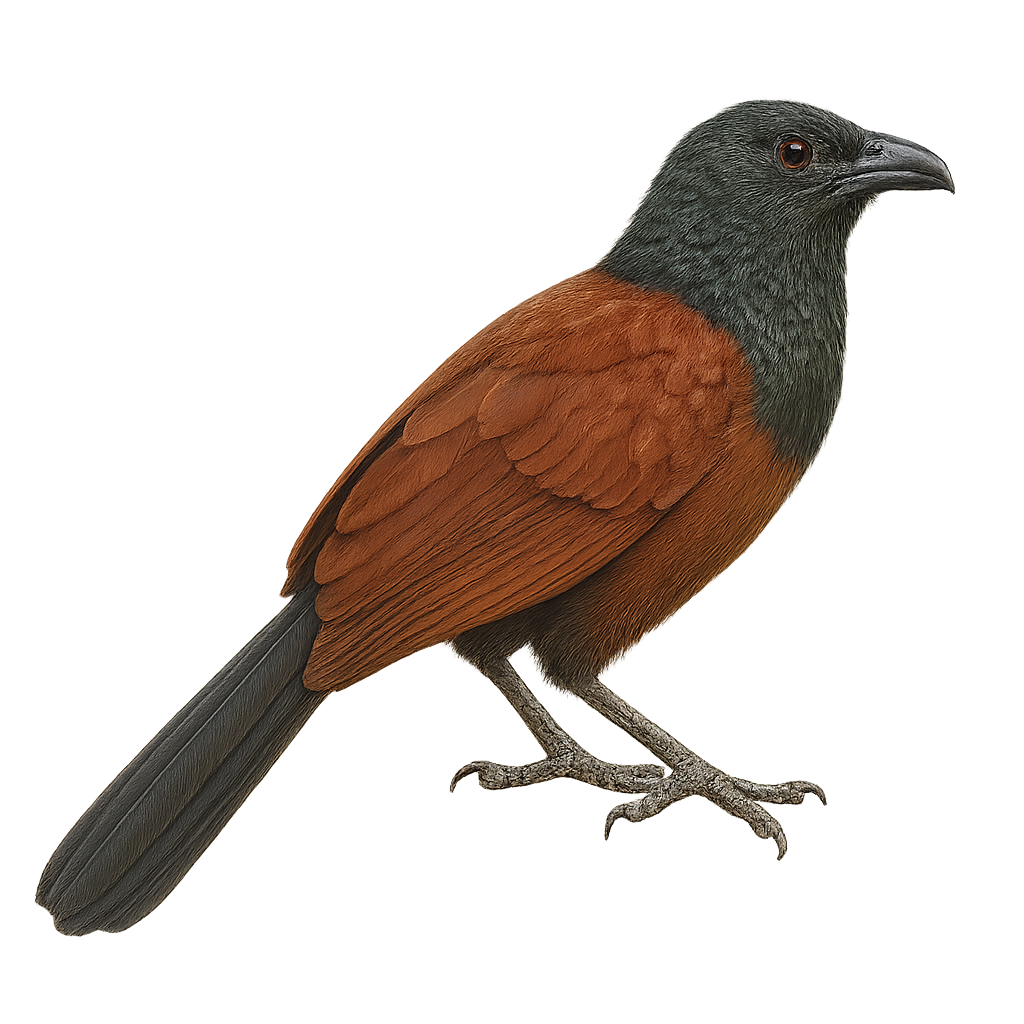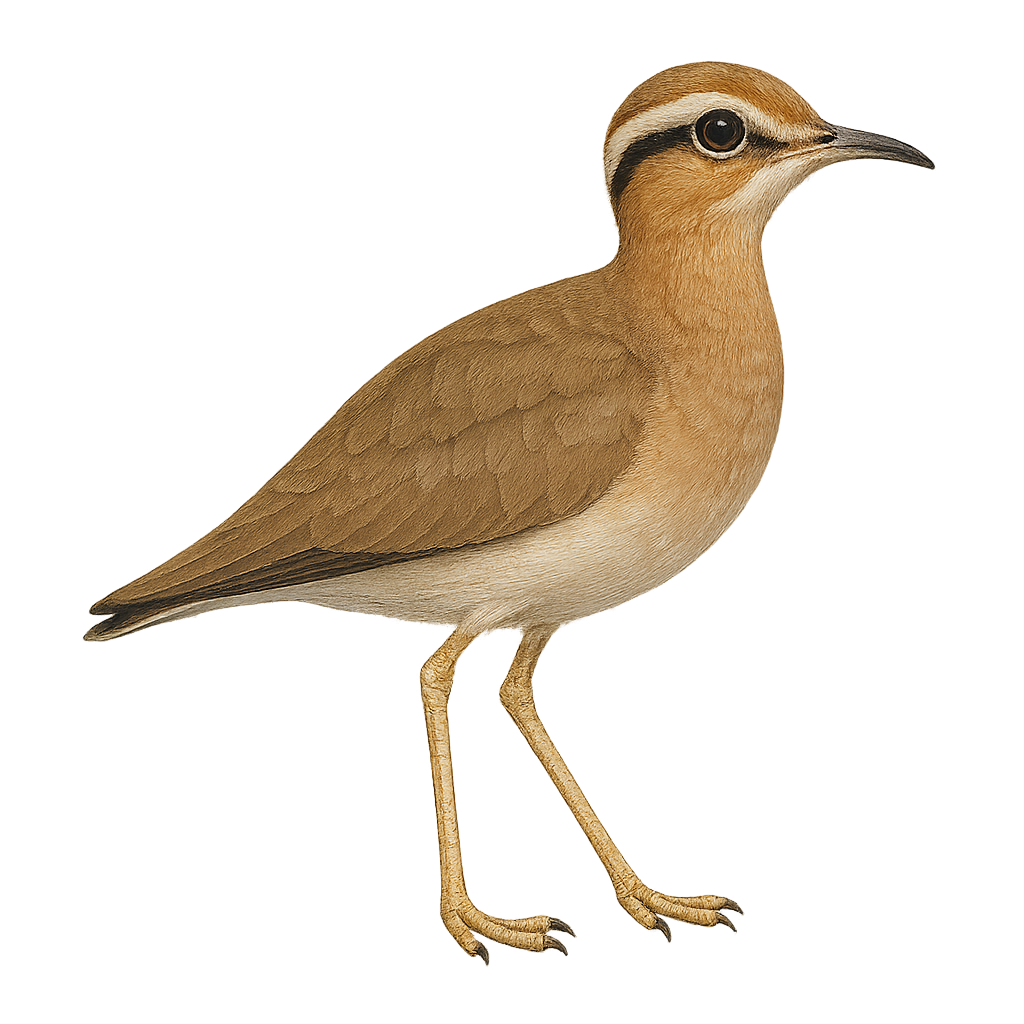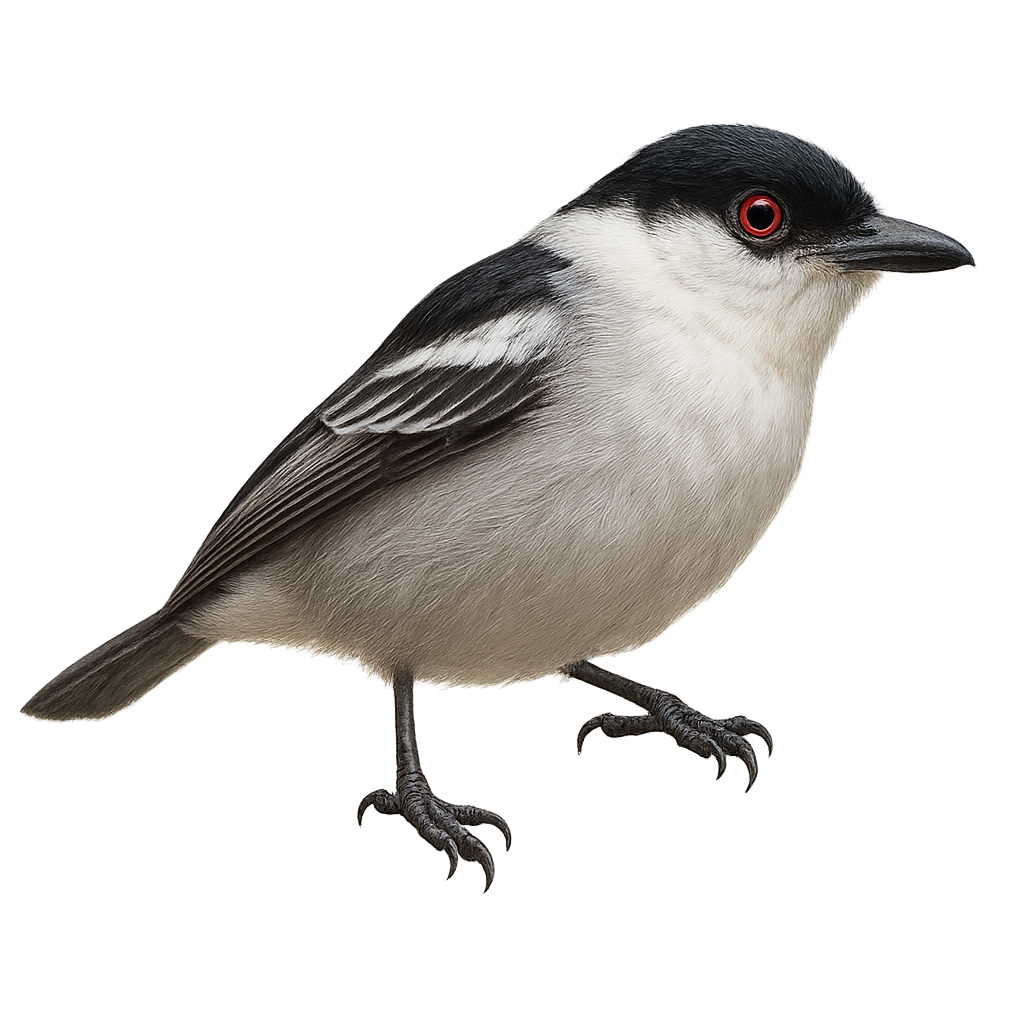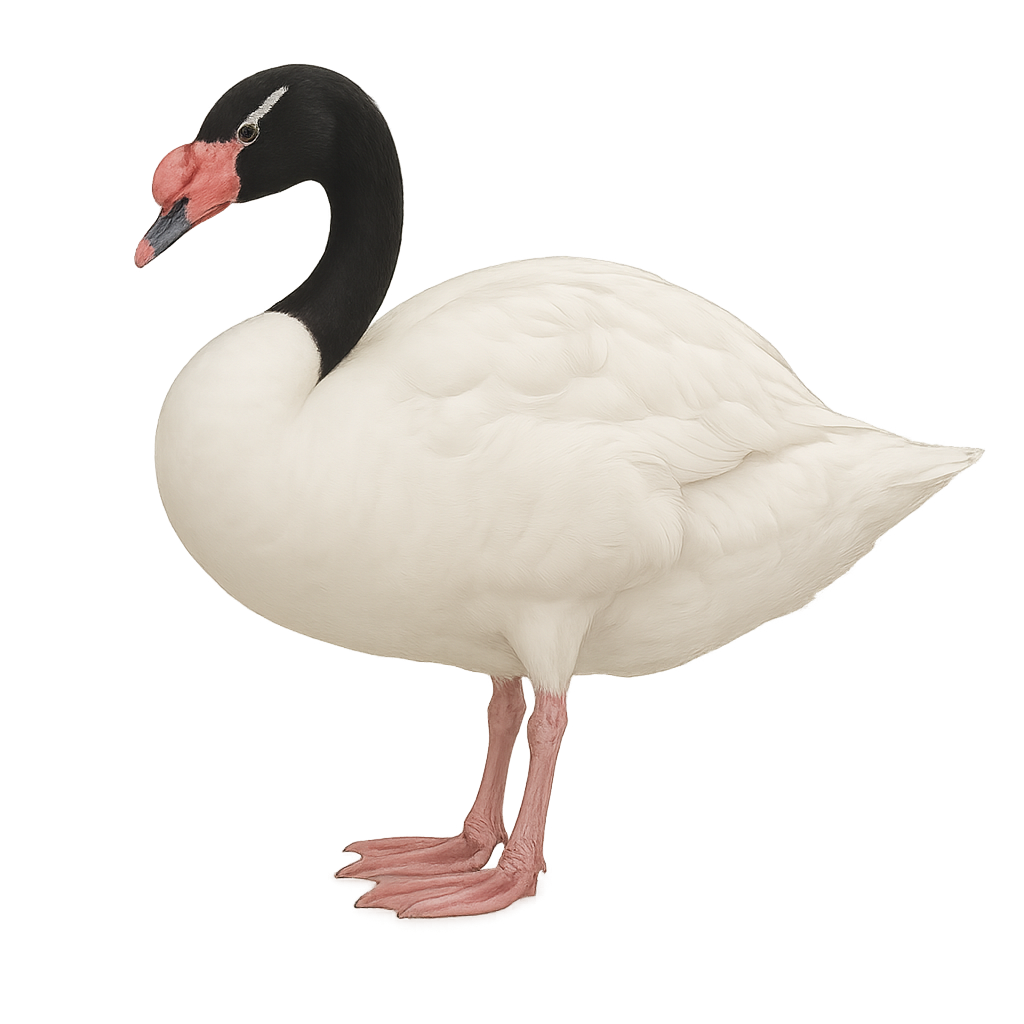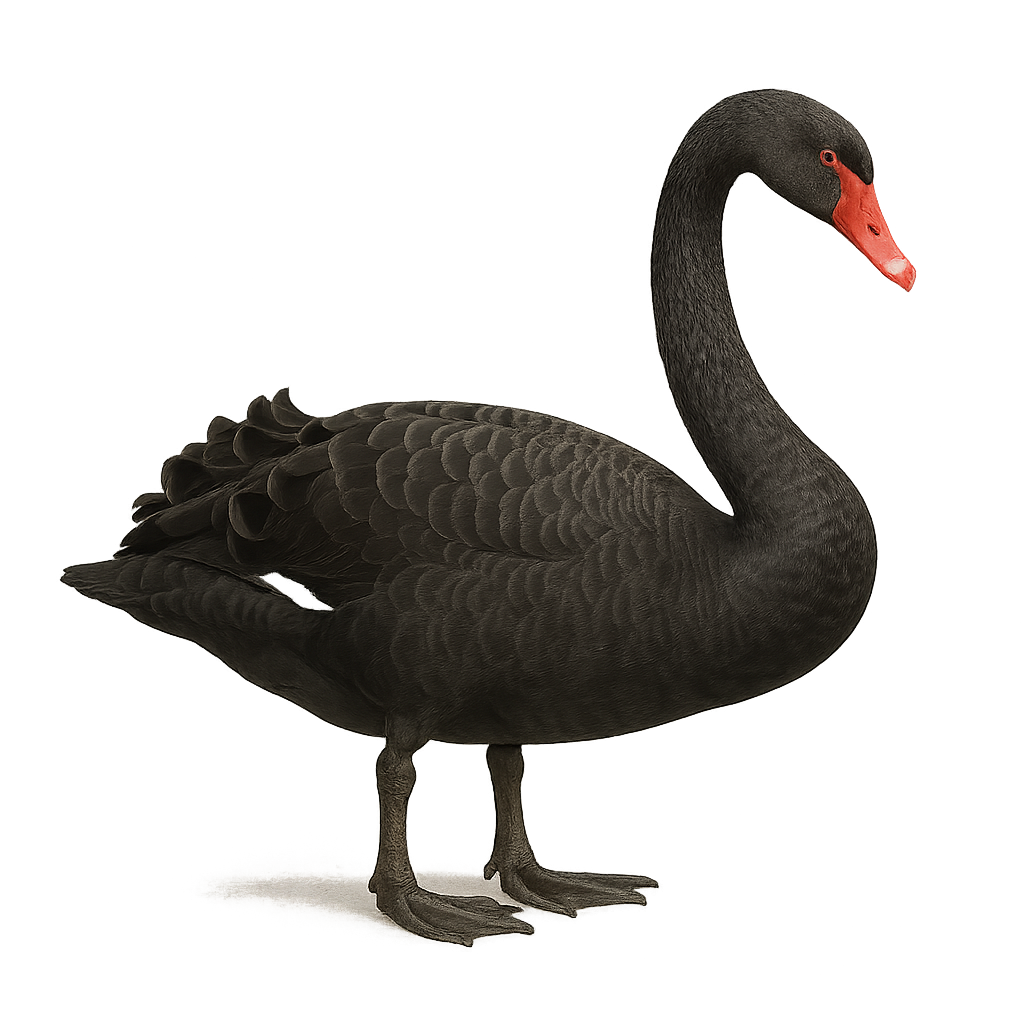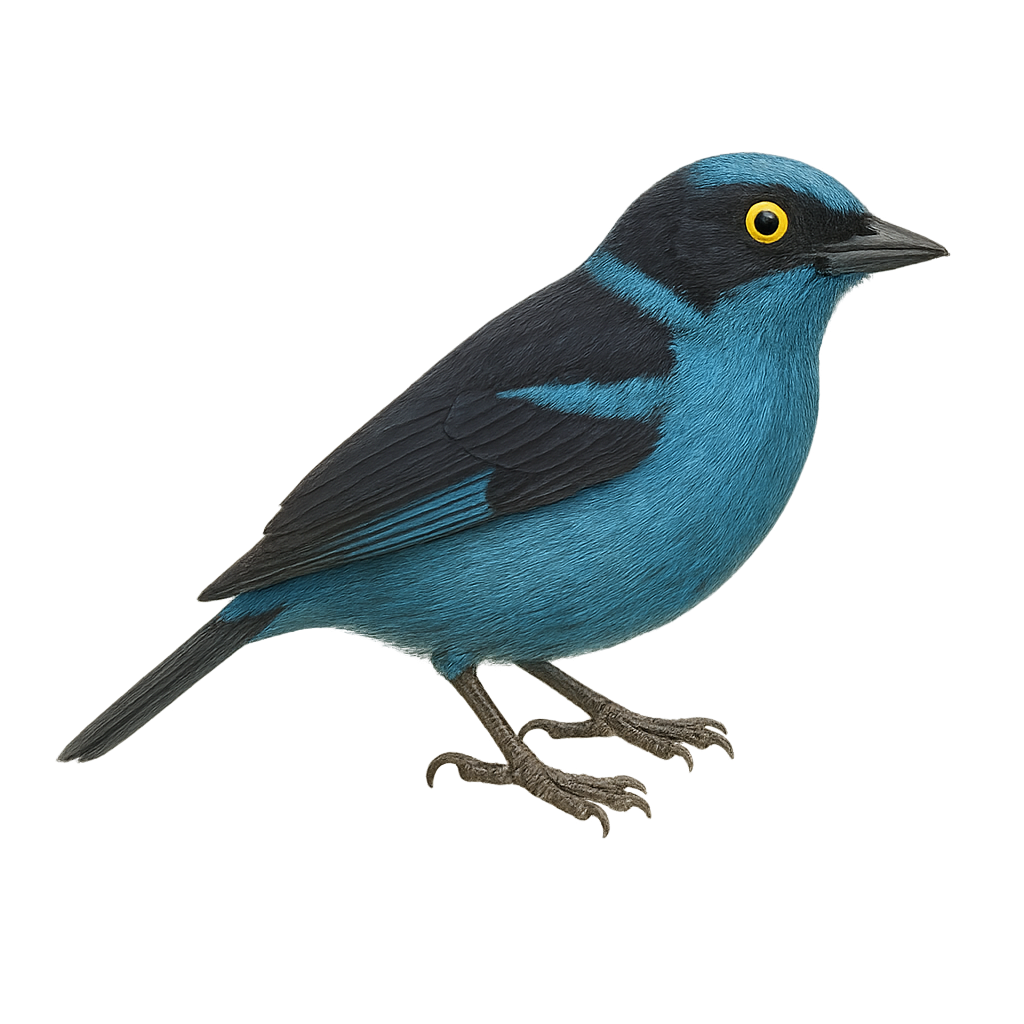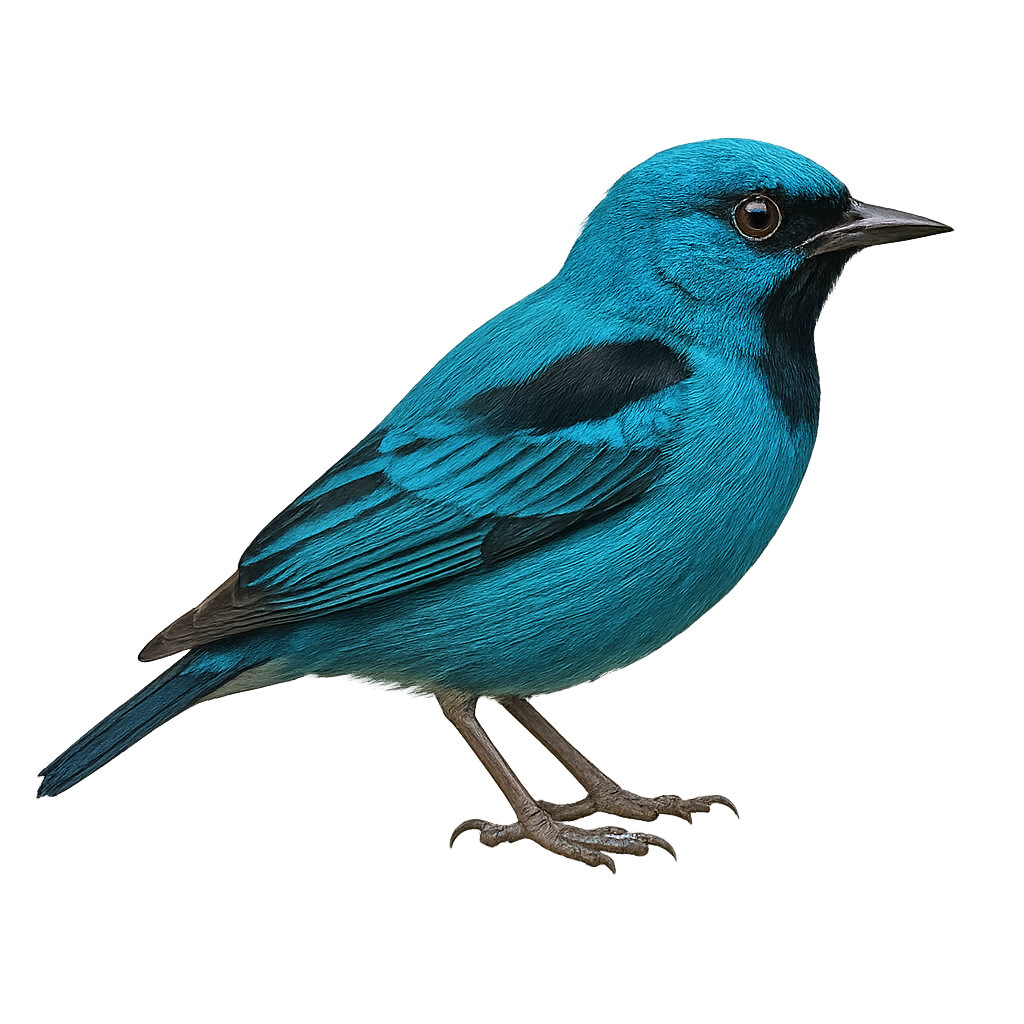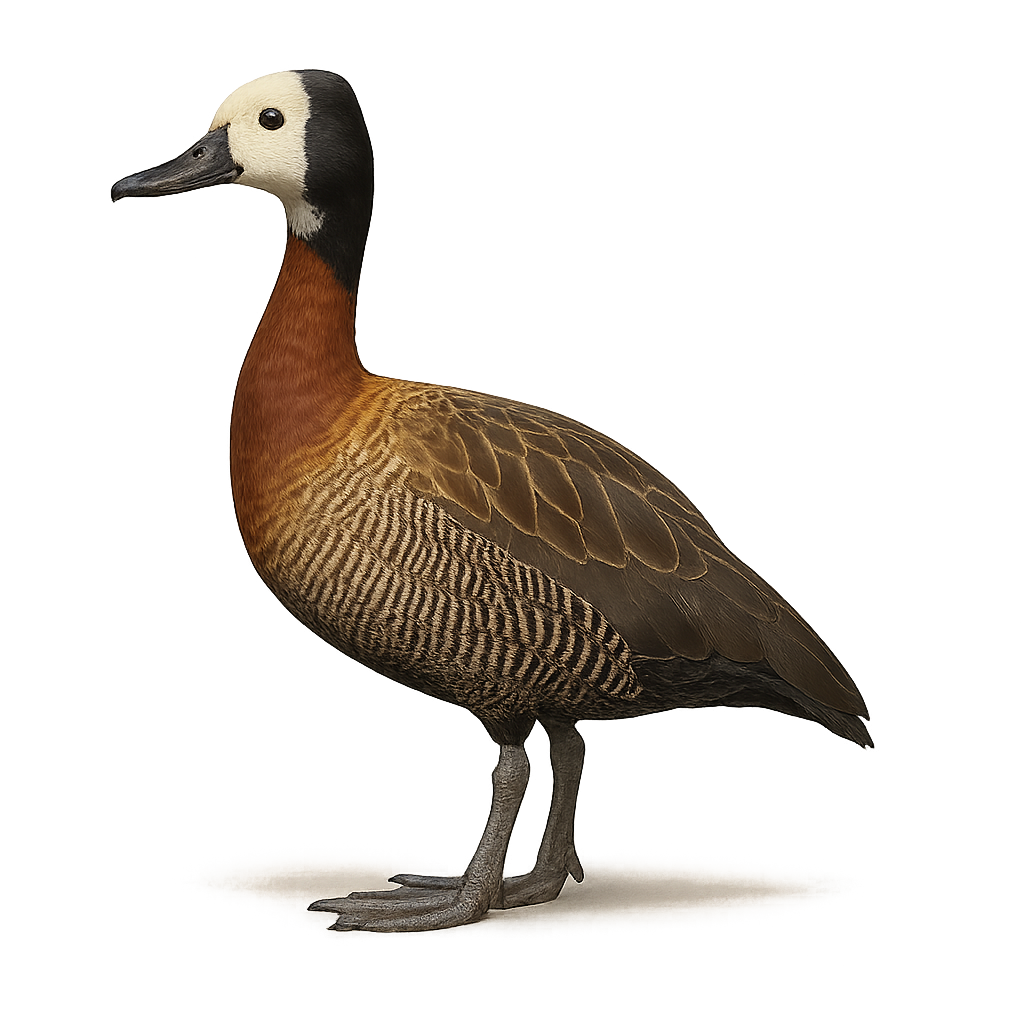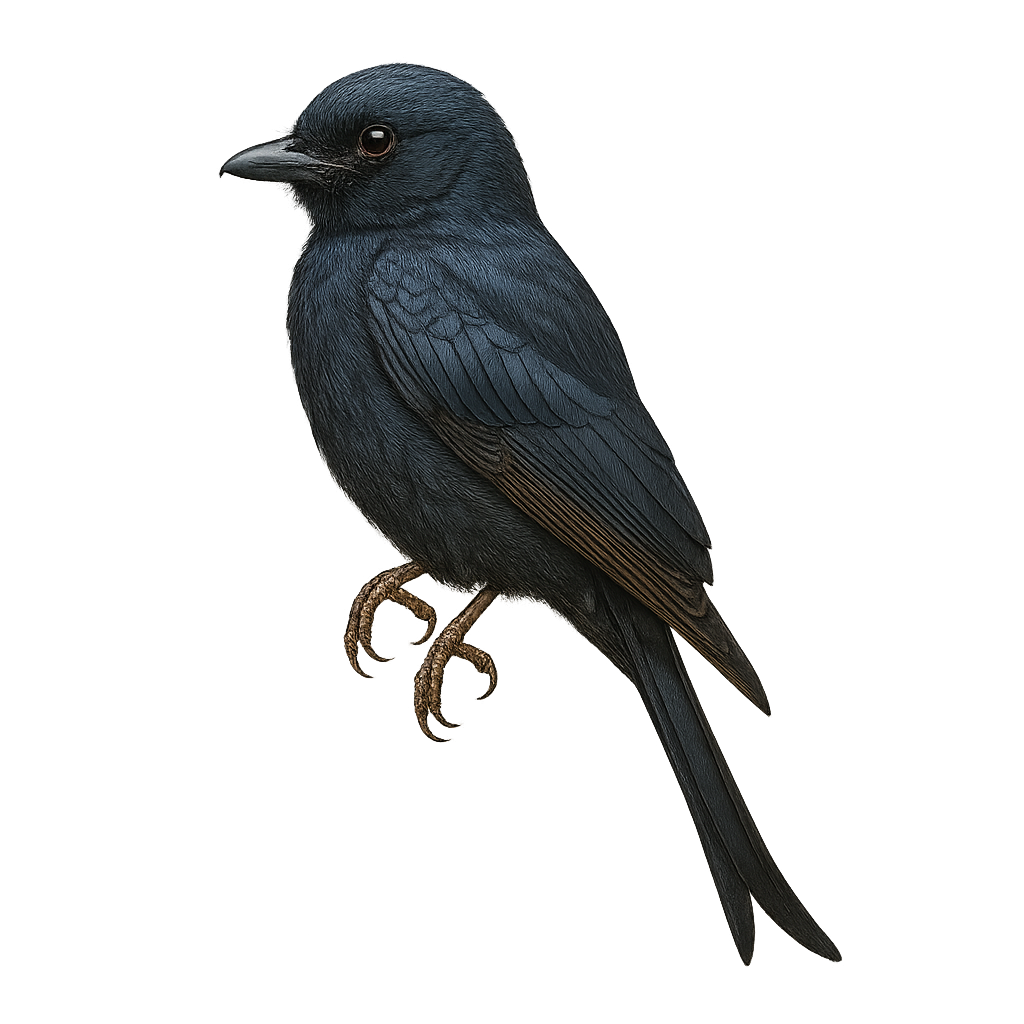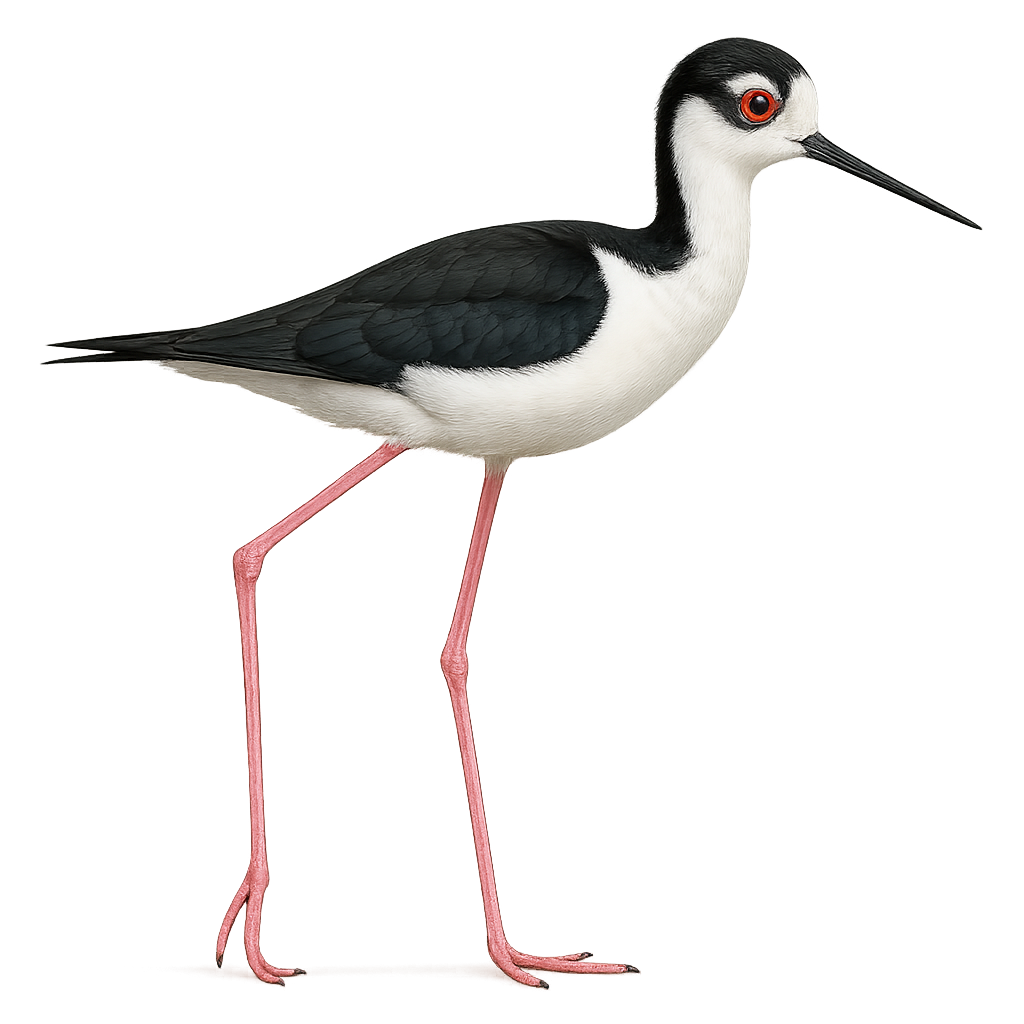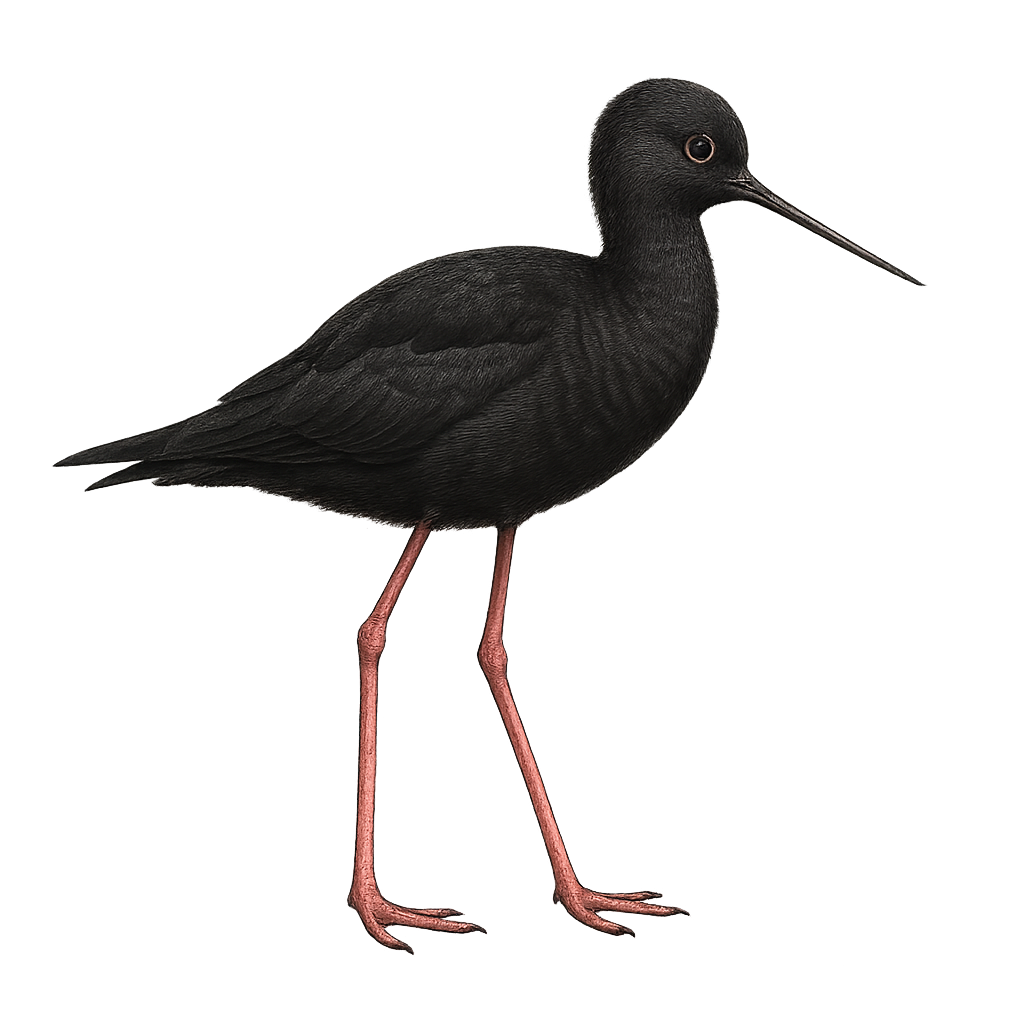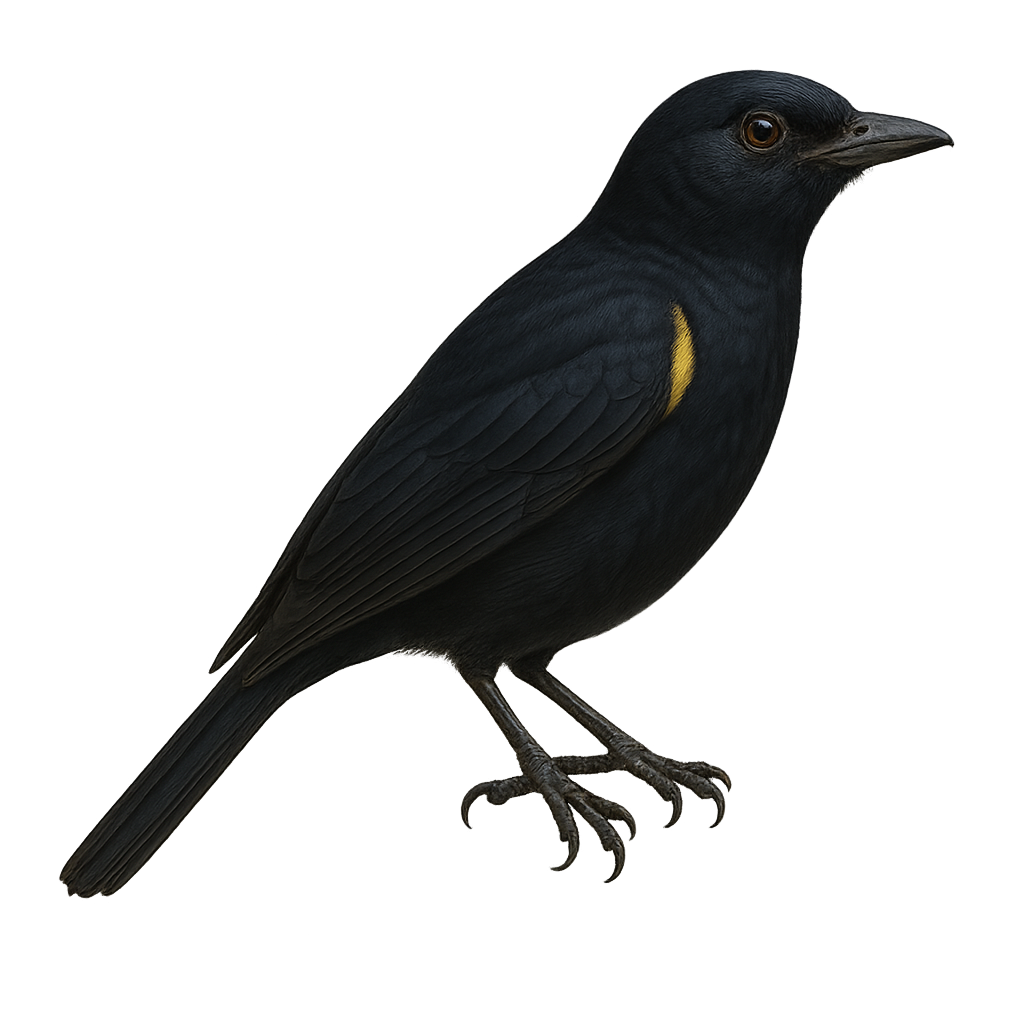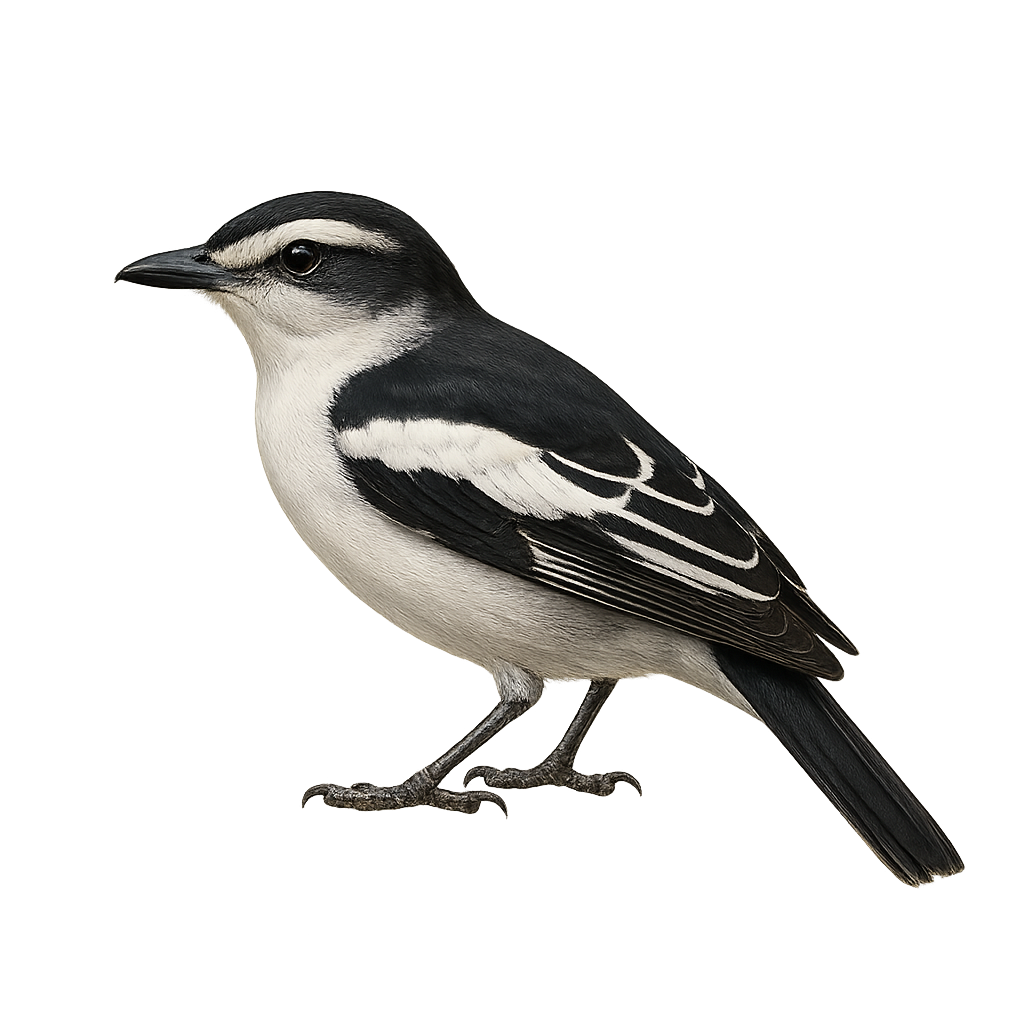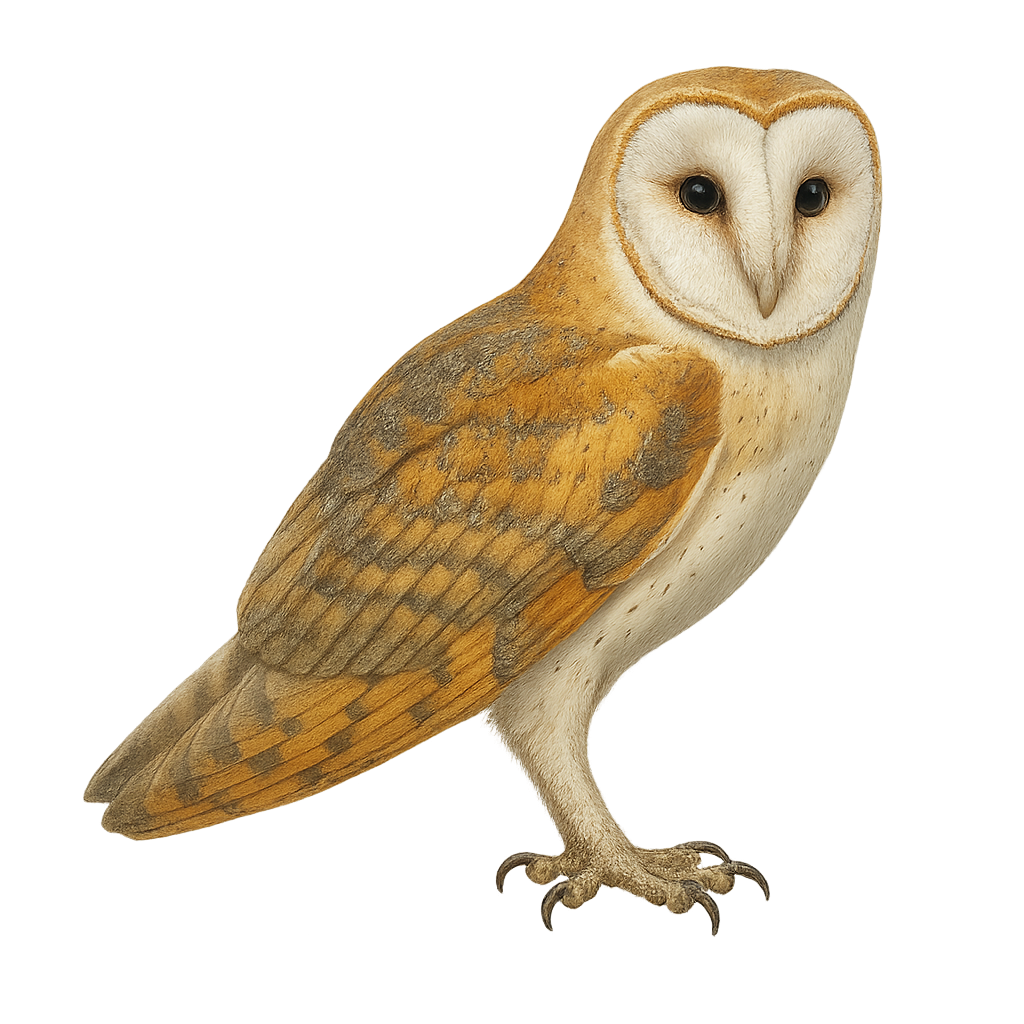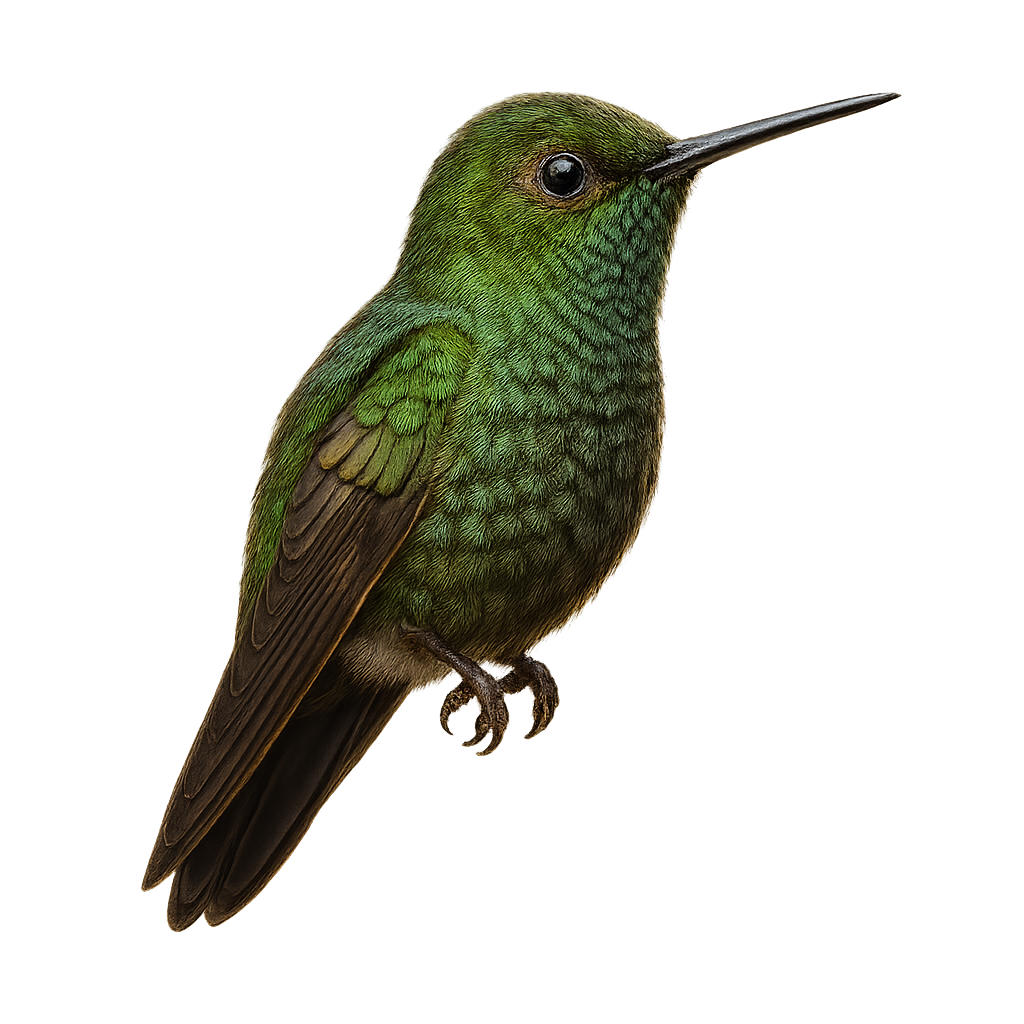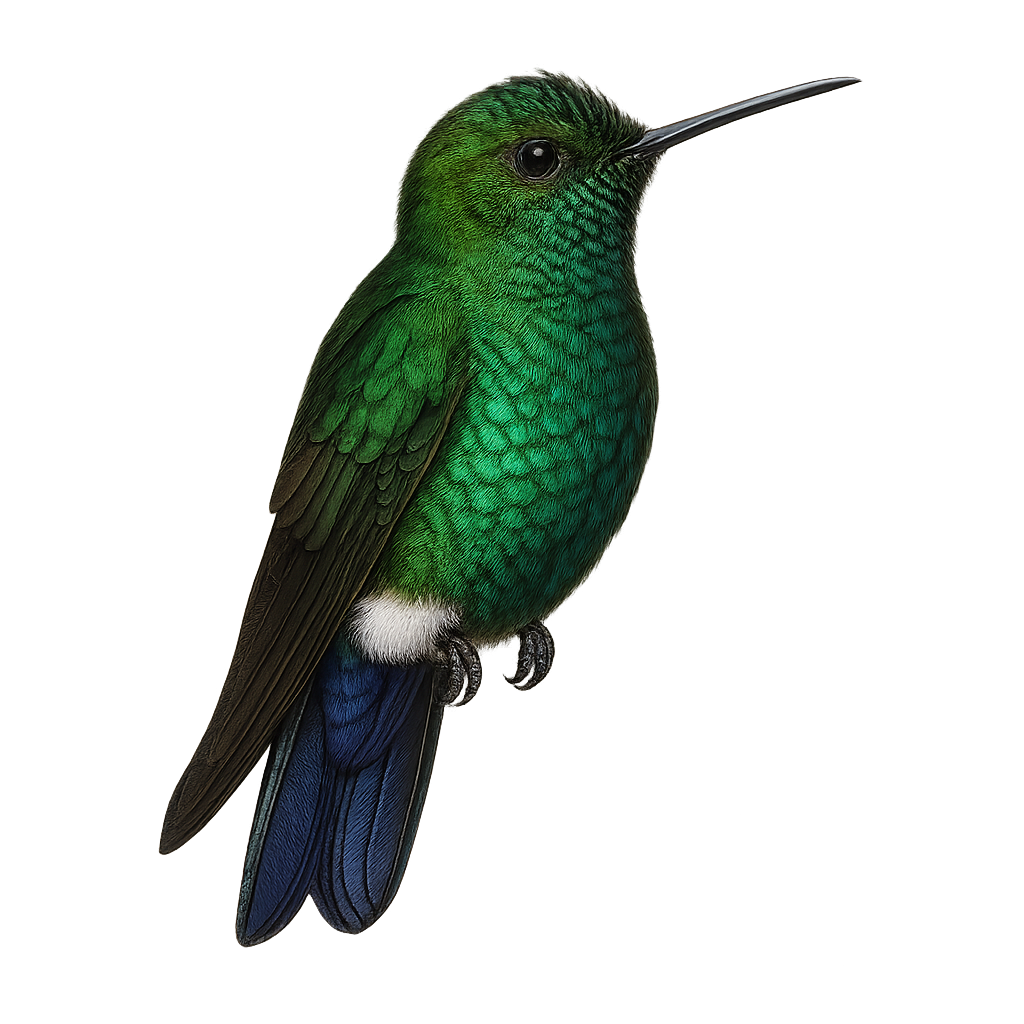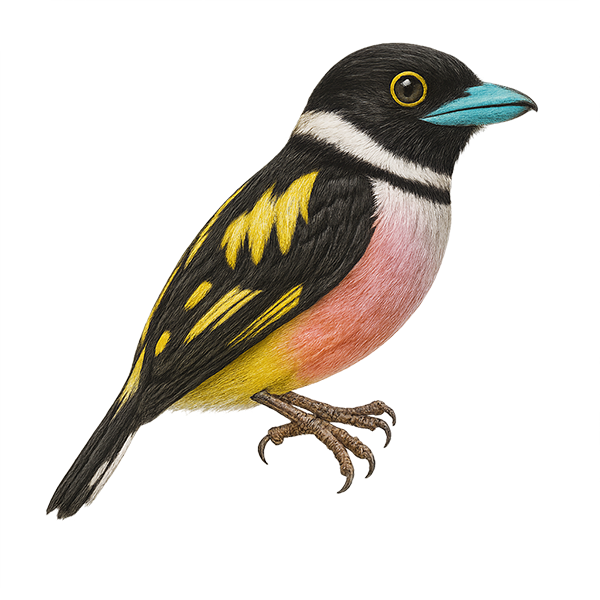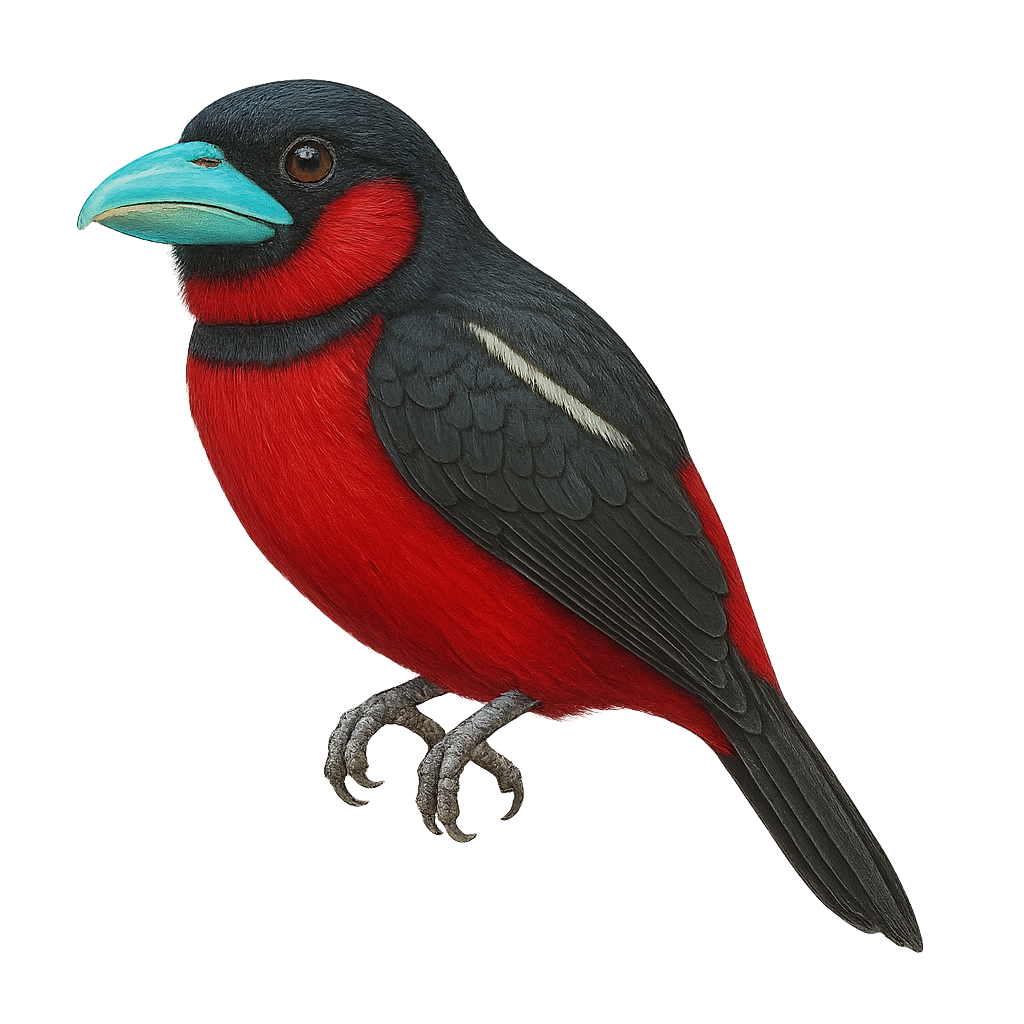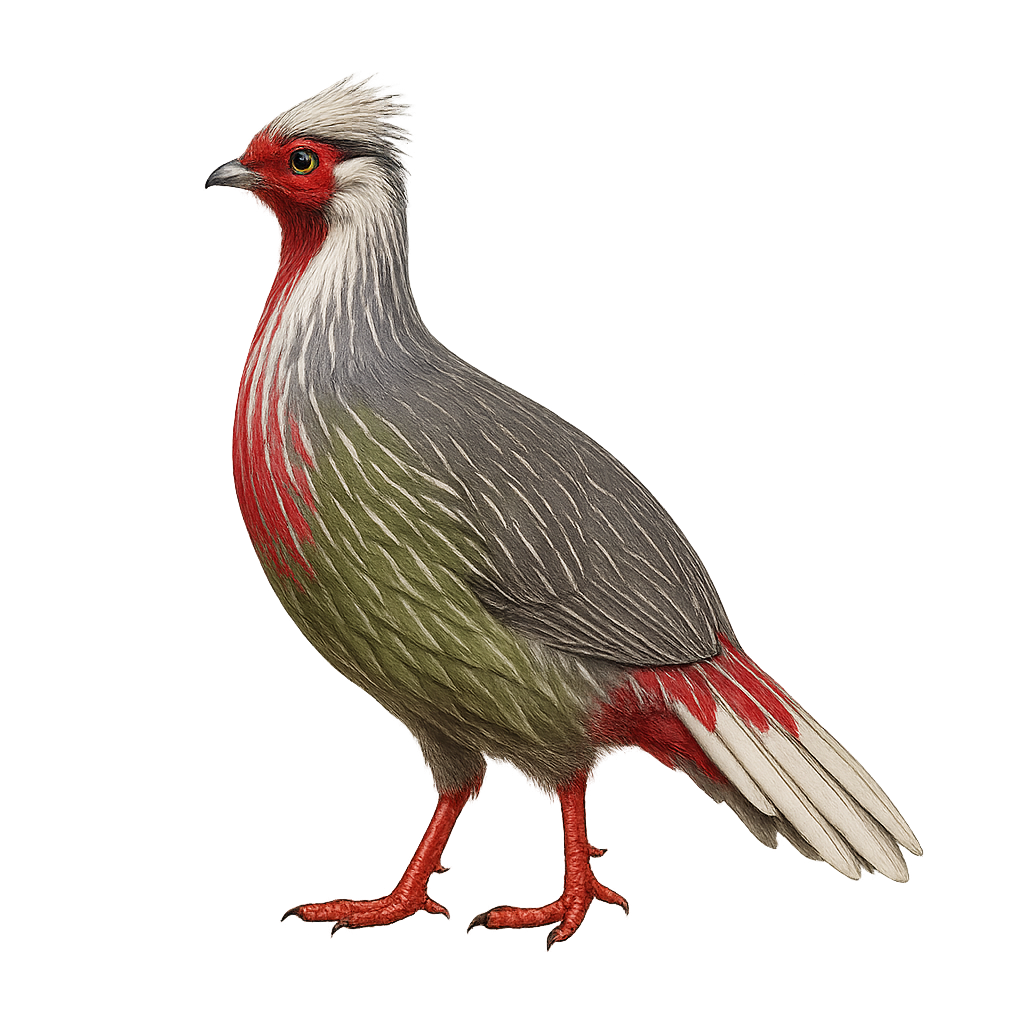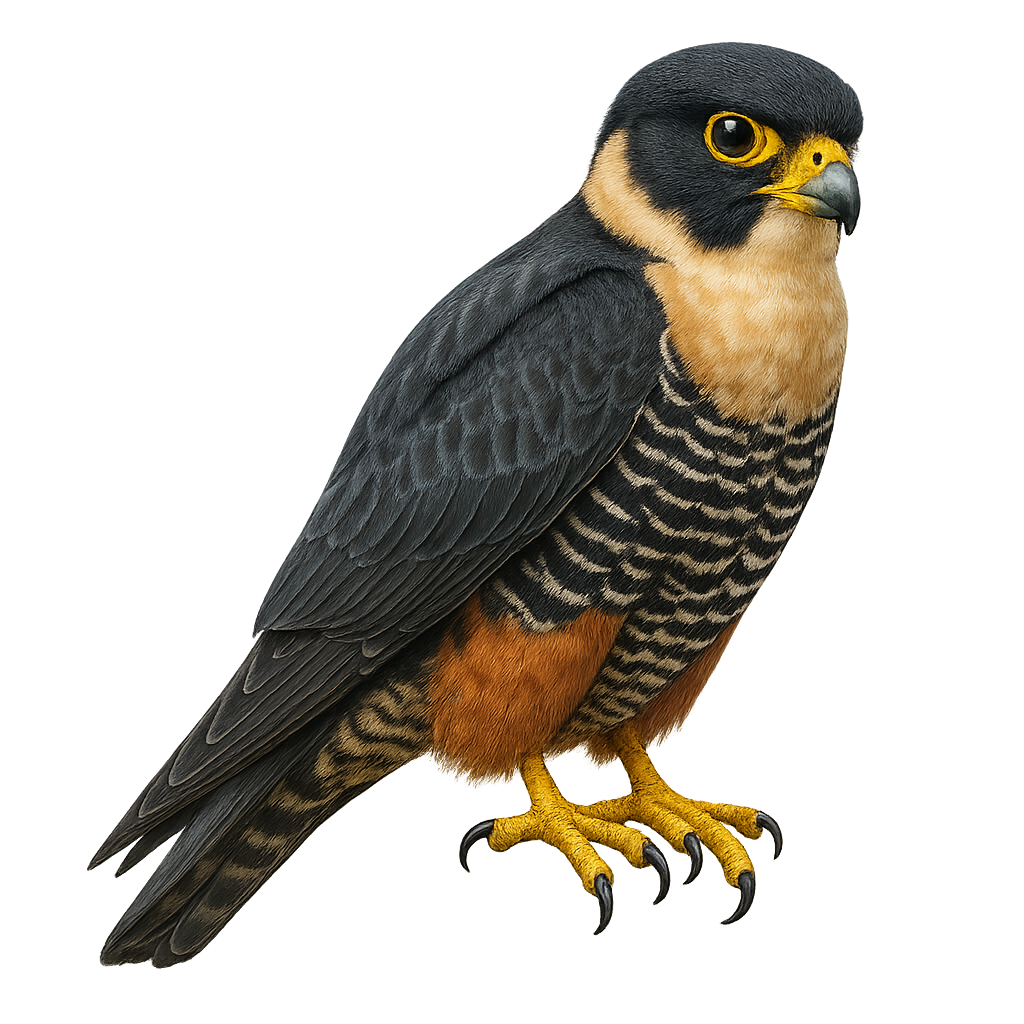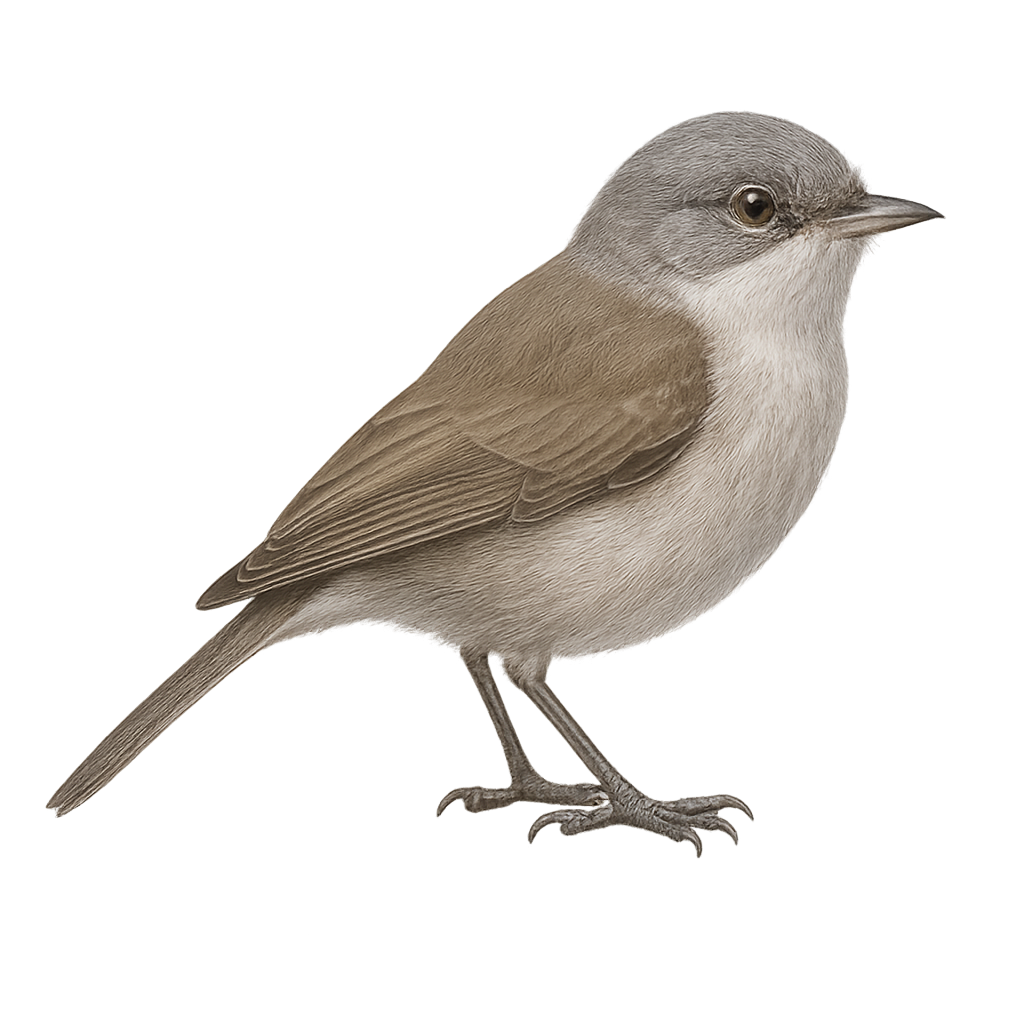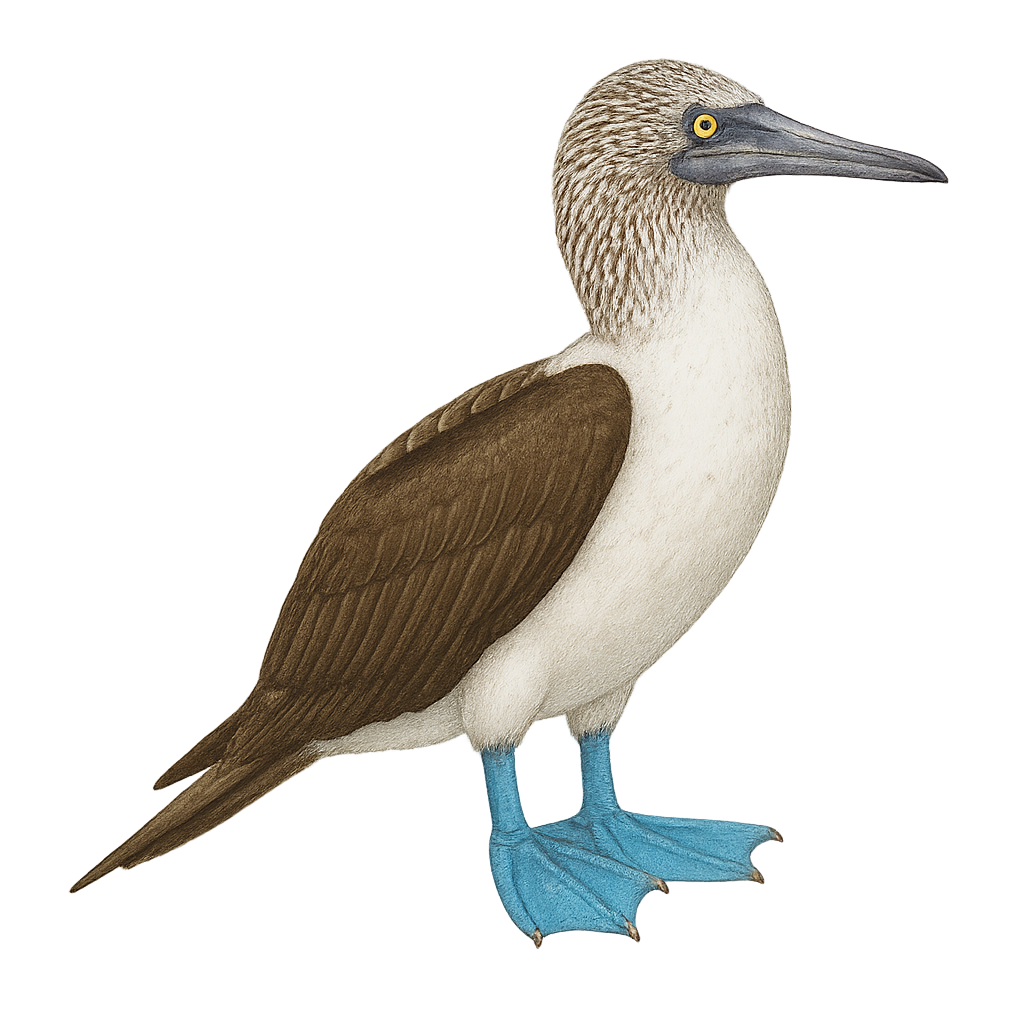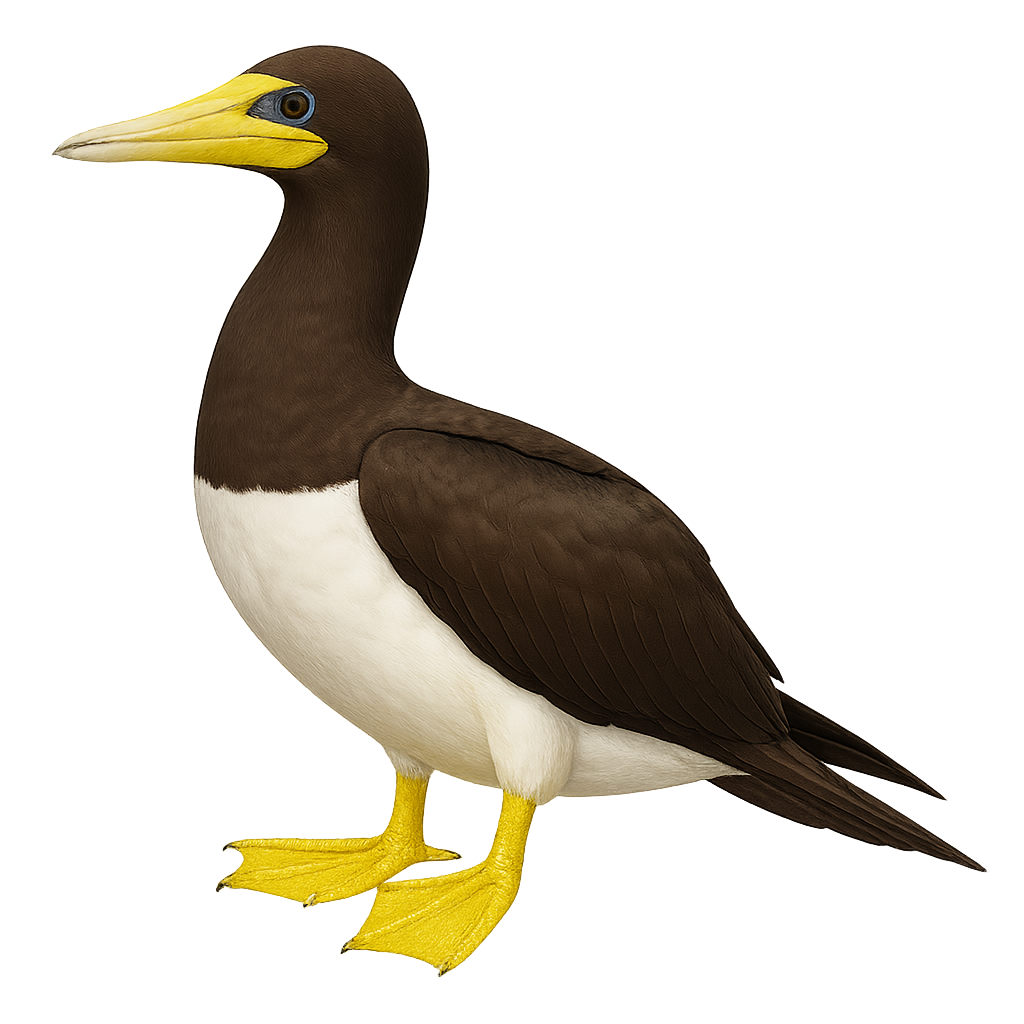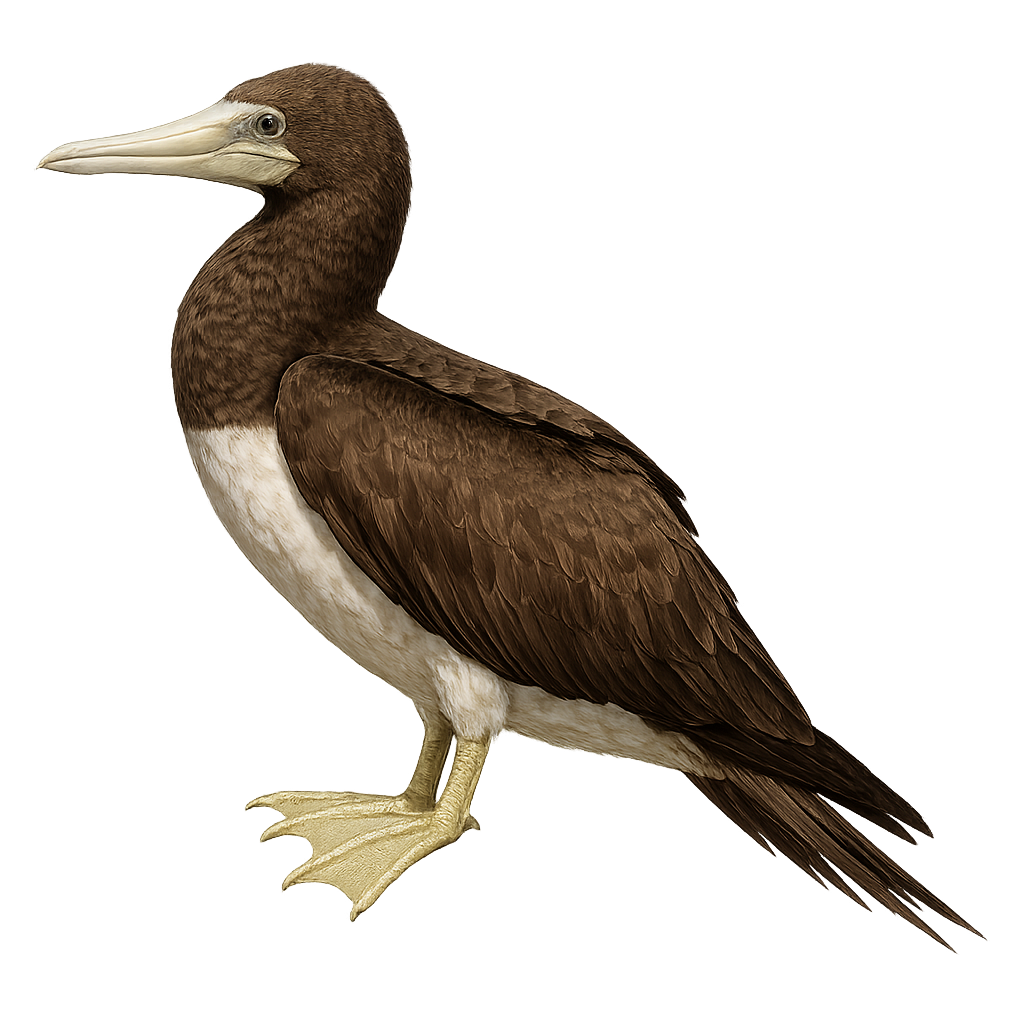The Bengal Coucal, or Centropus bengalensis, is a fascinating bird belonging to the Cuculidae family. It is primarily found in the humid and marshy regions of South and Southeast Asia. This bird is distinguished by its dark brown plumage and rufous wings, which contrast with its black head and tail. The coucal is a medium-sized bird, measuring about 40 to 50 cm in length. It is known for its discreet behavior and ability to move silently through dense undergrowth. The Bengal Coucal is an opportunistic predator, feeding on insects, small reptiles, and sometimes small mammals. Although it is mainly terrestrial, it can fly short distances.
The Burchell's Courser, scientifically known as Cursorius rufus, is an elegant terrestrial bird primarily found in the arid and semi-arid regions of southern Africa. Its plumage is dominated by shades of beige and brown, allowing it to blend seamlessly into its sandy environment. The wings feature distinctive black and white markings visible in flight. This bird is known for its long legs and slender bill, adapted to its ground-dwelling lifestyle. It primarily feeds on insects and other small invertebrates, which it captures by running swiftly on the ground. The Burchell's Courser is a diurnal bird, often seen alone or in small groups. Its ability to camouflage and discreet behavior make it sometimes difficult to spot.
The Black-backed Puffback, or Dryoscopus cubla, is a medium-sized bird belonging to the Malaconotidae family. It is primarily found in wooded areas and savannas of sub-Saharan Africa. This bird is distinguished by its black and white plumage, with a black back and white belly, hence its name. Males and females show slight sexual dimorphism, with males having brighter colors. Known for its melodious and varied song, it is often heard before being seen. The Black-backed Puffback is a territorial bird, usually living in pairs or small family groups. It primarily feeds on insects but can also consume fruits and seeds.
The Black-necked Swan, Cygnus melancoryphus, is a graceful waterbird native to South America. It is easily recognized by its pure white plumage contrasted with a black neck and a striking red knob at the base of its bill. Preferring freshwater lakes, lagoons, and marshes, it primarily feeds on aquatic plants. Known for its elegance, it swims gracefully and often forms monogamous pairs that share parental duties. While generally tolerant of humans, it can become wary if threatened. Its population is stable, but it remains vulnerable to environmental changes.
The black swan, Cygnus atratus, is a large waterbird native to Australia, easily identifiable by its black plumage and bright red bill. Measuring up to 1.4 meters in length with a wingspan reaching 2 meters, it is one of the largest swans. Black swans primarily inhabit lakes, rivers, and marshes, feeding on aquatic plants. They are known for their social behavior and often form groups. Nesting usually occurs on isolated islands or shores. Although mostly sedentary, some may migrate depending on climatic conditions.
The Blue Dacnis is a small, colorful bird native to the tropical forests of South America. It is easily identified by its striking plumage: males have a bright blue head and back, while females display greener hues. This passerine measures about 12 cm in length and primarily feeds on fruits, nectar, and insects. It is often seen in small groups or pairs, actively moving through the canopy in search of food. Although its habitat is threatened by deforestation, the Blue Dacnis remains relatively common within its range.
The Blue Dacnis, or Dacnis cayana, is a small, colorful bird found in the tropical forests of South America. Males display vibrant blue plumage with black wings and tail, while females are a more subdued green. Measuring about 12 to 13 cm, this bird is often seen in pairs or small groups. It primarily feeds on fruits, nectar, and insects, playing a role in pollination and seed dispersal. The Blue Dacnis is a diurnal bird, most active in the morning and late afternoon. It is known for its melodious song and aerial acrobatics when feeding in the canopy.
The black-bellied whistling duck is a whistling duck in the family Anatidae, 47–56 cm long, with a long neck, pink bill and grey-brown plumage. It inhabits shallow freshwater ponds, marshes and lakes, feeding on seeds, aquatic plants and small invertebrates. Gregarious and cavity-nesting, it breeds colonially in tree hollows or nest boxes.
The Black Drongo, Dicrurus macrocercus, is an elegant and agile bird, easily recognizable by its glossy black plumage and long forked tail. This passerine is widely distributed in South and Southeast Asia, where it inhabits various environments such as open fields, light forests, and agricultural areas. Known for its aggressive behavior, it does not hesitate to chase away larger predators to protect its territory. The Black Drongo is also an excellent mimic of sounds, allowing it to deceive other species. Its diet mainly consists of insects, which it catches in flight thanks to its remarkable aerial abilities.
The Black-winged Stilt is an elegant wader bird, easily recognized by its long, slender legs and bright white plumage. Measuring around 35 to 40 cm in length and with a wingspan of 70 to 80 cm, this bird is distinguished by its fine, straight black beak, which is slightly upturned. The Black-winged Stilt primarily inhabits wetlands, marshes, shallow rivers, and ponds across Europe, Asia, and North Africa. It mainly feeds on aquatic insects, crustaceans, and small fish, which it catches by walking in shallow water and probing with its beak. This wader is particularly known for its graceful way of moving on its long legs, often walking slowly in the water or performing elegant hops. During the breeding season, the Black-winged Stilt builds its nest on isolated islands or sandbanks, where females lay 3 to 4 eggs. The species is listed as of least concern, although it is vulnerable to habitat loss and water pollution.
The Black-necked Stilt is an elegant and graceful bird, easily recognizable by its long red legs and distinctive black and white plumage. It primarily inhabits wetlands, marshes, and shallow ponds where it feeds on small invertebrates and crustaceans. This bird is often seen in small groups but can also be solitary. Its slender silhouette and delicate movements make it a fascinating sight for birdwatchers and nature enthusiasts. Although its range is primarily in America, it is sometimes observed in other regions during migrations. Its ability to adapt to various wetland habitats makes it a resilient species, although some populations are threatened by habitat loss.
The Black Stilt, or Himantopus novaezelandiae, is a wading bird endemic to New Zealand. It is characterized by its uniform black plumage, long red legs, and slender black bill. This rare and endangered bird prefers aquatic habitats such as lakes, rivers, and marshes. Its population is declining due to predation by introduced species and habitat loss. Conservation efforts include protecting breeding sites and captive breeding programs. The Black Stilt is a symbol of New Zealand's unique biodiversity and the importance of conserving endangered species.
The Black Cuckooshrike, or Campephaga flava, is a medium-sized bird, predominantly black with bluish sheen in males, while females have duller, often brownish, streaked plumage. It is mainly insectivorous, feeding on caterpillars and other insects found in trees and shrubs. This bird is often seen alone or in pairs and is known for its melodious and varied song. It primarily inhabits wooded savannas, open forests, and shrublands in sub-Saharan Africa. Although quite discreet, it can be spotted by its distinctive song.
The Black-winged Cuckooshrike is a medium-sized bird known for its distinctive grey and black plumage. It primarily inhabits tropical and subtropical forests, where it feeds on insects and fruits. This bird is often seen in small groups or pairs, actively moving through the canopy in search of food. Its ability to blend into its environment with its dark plumage sometimes makes it difficult to spot. Although not endangered, deforestation poses a potential risk to its natural habitats. It is appreciated by birdwatchers for its melodious song and discreet presence.
The American Barn Owl, or Tyto furcata pratincola, is a medium-sized nocturnal raptor, easily identified by its heart-shaped facial disc and pale plumage. It is widespread across the Americas and inhabits farmland, open grasslands, wetlands, and man-made structures like barns and silos. Its flight is completely silent, making it an efficient hunter of small mammals, especially rodents. Its sharp, screeching call contrasts with its ghostly appearance. The population is generally stable but may be affected by the loss of nesting sites and pesticide use. No black or melanistic form is known in this subspecies.
The Barn Owl is a nocturnal bird of prey, easily recognizable by its heart-shaped face and large white wings. It typically measures between 33 and 40 cm in length, with a wingspan of 80 to 95 cm. Its plumage is mainly white with beige and brownish hues on its back, while its face, with its distinct shape, is a bright white, making it immediately identifiable. The Barn Owl primarily inhabits agricultural areas, open meadows, clear forests, and abandoned buildings or churches, where it finds places to nest. It primarily feeds on small mammals, such as mice and voles, but may also hunt birds or insects. Its hunting method is very silent, due to the unique structure of its feathers, which reduce flight noise. It is a solitary bird that usually hunts at night. While the Barn Owl is not currently endangered, it faces threats such as habitat loss, secondary poisoning from consuming contaminated prey, and collisions with vehicles.
The Buff-tailed Coronet, or Haplophaedia assimilis, is a fascinating small hummingbird known for its striking plumage and distinctive tail. This bird features predominantly green plumage with metallic sheens, while its tail is relatively long and slender, giving it its name. It is mainly found in the humid forests of the Andes, where it feeds on nectar and plays a crucial role in pollinating local plants. Its fast and agile flight allows it to move easily between flowers. Although discreet, it is often observed defending its territory against other hummingbirds. The Buff-tailed Coronet is a perfect example of hummingbird adaptation to mountainous environments.
The Black-breasted Puffleg, or Eriocnemis nigrivestis, is a hummingbird endemic to the Ecuadorian Andes. This small bird is particularly recognizable by its black crest and white feather tufts on its legs, which give it its name. Males display a shiny black plumage with bluish hues, while females are duller with greenish tones. This hummingbird primarily inhabits cloud forests and shrublands at high altitudes. Unfortunately, it is considered critically endangered due to deforestation and habitat loss. Conservation efforts are crucial to ensure its survival.
The Buff-tailed Coronet, Eriocnemis vestita, is a fascinating bird from the Trochilidae family. This small hummingbird is recognizable by its fluffy white feathered legs, contrasting with its metallic green plumage. It primarily inhabits cloud forests and mountainous areas of the Andes, where it feeds on nectar and insects. Its fast and agile flight allows it to easily navigate between flowers. Although its habitat is relatively stable, it is sensitive to environmental disturbances. Males and females are similar in appearance, although males may be slightly more colorful. This hummingbird plays an essential role in pollinating the plants in its habitat.
The Black Hermit, Threnetes niger, is a discreet and fascinating hummingbird primarily found in the dense tropical forests of Central and South America. This small bird is recognizable by its dark plumage and slightly curved bill, adapted for extracting nectar from tubular flowers. Although its appearance is modest compared to other hummingbirds, the Black Hermit plays a crucial role in the pollination of plants in its habitat. It is often seen darting quickly from flower to flower, emitting high-pitched, buzzing sounds. Its ability to blend into its environment makes it difficult to spot, but its presence is essential to the ecological balance of its ecosystem.
The Black-and-yellow Broadbill is a captivating bird, easily identifiable by its vibrant plumage and distinctive black cap. It primarily inhabits the tropical forests of Southeast Asia, where it feeds on insects and fruits. Its melodious song and vivid colors make it a favorite among birdwatchers. This bird is often seen in pairs or small groups, moving nimbly among the branches. Although its habitat is threatened by deforestation, it remains relatively common in some areas. The Black-and-yellow Broadbill builds hanging nests, often over water, to protect its eggs from predators.
The Black-and-red Broadbill is a striking bird known for its vibrant plumage and large bill. It features a vivid combination of black and red body with a broad, pale blue bill. This bird is primarily arboreal and found in the tropical forests of Southeast Asia, including Thailand, Malaysia, and Indonesia. It feeds mainly on insects and small fruits, which it skillfully captures with its powerful bill. The Black-and-red Broadbill is often seen in pairs or small groups and is known for its melodious calls. Although its habitat is threatened by deforestation, it is currently classified as Least Concern by the IUCN.
The Blue Bunting, or Cyanocompsa parellina, is a medium-sized songbird belonging to the Cardinalidae family. It is primarily found in the tropical and subtropical regions of Central America, particularly in Mexico and Guatemala. This bird is distinguished by its bright blue plumage in males, while females have duller, often brownish tones. The Blue Bunting is a discreet bird, often seen foraging for seeds and insects in dense undergrowth. It is known for its melodious song, often heard at dawn and dusk. Although not currently threatened, deforestation poses a potential risk to its natural habitat.
The Blood Pheasant, or Ithaginis cruentus, is a captivating bird native to the mountainous regions of the Himalayas. This pheasant is notable for its colorful plumage, featuring shades of red, green, and gray, giving it a unique appearance. Males display brighter colors than females, which is typical among many bird species. They live in family groups and are often seen foraging on the forest floor, feeding on seeds, berries, and insects. Their natural habitat ranges from coniferous forests to alpine meadows, typically between 2,400 and 4,500 meters in altitude. Although relatively discreet, their distinctive call can be heard echoing through the mountain valleys.
The Bat Falcon is a small, elegant raptor, recognizable by its distinctive rufous throat and contrasting black and white plumage. It primarily inhabits the dense tropical forests of Central and South America, where it hunts mainly birds and bats in flight. This falcon is an agile and fast hunter, often seen soaring high in the sky before diving onto its prey with remarkable precision. Although primarily diurnal, it can sometimes be active at dusk. Its ability to adapt to various habitats, including urban areas, makes it a fascinating bird to observe for ornithologists and nature enthusiasts.
The blackcap is a small passerine bird found primarily in forests, hedgerows, and gardens across Europe and Western Asia. It is easily recognized by its black head in the male (brown in the female) and its gray-olive plumage. This bird is an excellent singer, with a melodious song composed of trills and whistles. It feeds on small insects, berries, and seeds. Very discreet, it often goes unnoticed despite its frequent presence.
The barred warbler is a small bird found primarily in bushes and hedgerows in agricultural areas and open woodlands across Europe and Asia. It is easily recognized by its grey-brown plumage and characteristic dark streaks on its back and wings. This passerine bird is very active, often moving through foliage in search of insects and berries. The barred warbler is also known for its rich and varied song.
The Blue-footed Booby is a distinctive seabird known for its striking blue feet, primarily found along the Pacific coasts. They are most commonly seen on the Galápagos Islands, where they breed in colonies. Their courtship dance, where the male displays his vibrant feet to attract a mate, is captivating. They primarily feed on fish, diving with remarkable precision. Their plumage is mostly white with brown wings and tail. Juveniles have grey feet that turn blue as they mature. While often seen in groups, they can also be solitary when hunting.
The Brown Booby, Sula leucogaster, is a medium-sized seabird easily identified by its chocolate-brown plumage contrasted with a white belly. It has a strong, pointed beak, perfect for catching fish by diving from the air. Adults measure about 70 to 80 cm in length with a wingspan of 130 to 150 cm. They are often seen gliding over tropical and subtropical waters, feeding mainly on fish and squid. The Brown Booby is a gregarious bird, often seen in colonies on rocky islands where it nests. Its population is stable, although threats such as pollution and habitat disturbance can affect it locally.
The Brewster's Booby, or Sula brewsteri, is a medium-sized seabird belonging to the Sulidae family. It is characterized by its bright white plumage, black wings and tail, and pale blue bill. Mainly found in the Gulf of California and along the Pacific coasts of Mexico, this bird is an excellent diver, feeding primarily on fish and squid. It nests in colonies on rocky islands, usually laying two eggs. The young are fed by regurgitation by both parents. Although its conservation status is currently of concern, it is vulnerable to human disturbances and climate changes affecting its nesting habitats.


